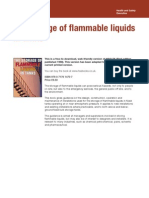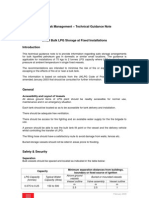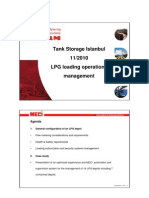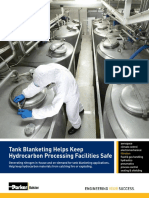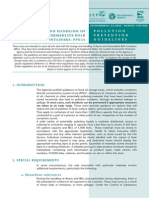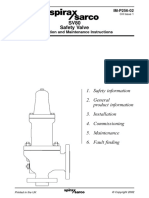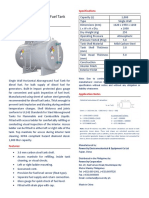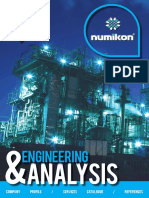Above Ground Oil Storage Tanks
Above Ground Oil Storage Tanks
Uploaded by
Tarjo SutedjoCopyright:
Available Formats
Above Ground Oil Storage Tanks
Above Ground Oil Storage Tanks
Uploaded by
Tarjo SutedjoOriginal Description:
Copyright
Available Formats
Share this document
Did you find this document useful?
Is this content inappropriate?
Copyright:
Available Formats
Above Ground Oil Storage Tanks
Above Ground Oil Storage Tanks
Uploaded by
Tarjo SutedjoCopyright:
Available Formats
P O L L U T I O N
P R E V E N T I O N
G U I D E L I N E S
ABOVE GROUND OIL
STORAGE TANKS:
PPG2
These guidelines are intended to assist those responsible for above ground oil storage tanks at sites other than oil refineries and
distribution depots. They are jointly produced by the Environment Agency for England and Wales, the Scottish Environment Protection
Agency and the Environment and Heritage Service in Northern Ireland, referred to as the Agency or Agencies. In England, the storage
of oils (except waste oils) is regulated under the Control of Pollution (Oil Storage)(England) Regulations 2001. The regulations apply
to industrial, commercial and institutional sites storing more than 200 litres of oil and private dwellings storing more than 3,500
litres. Highlighted text in these guidelines indicates areas that must be complied with under these regulations. Similar regulations are
due to be introduced in Scotland. Further advice may be obtained from your local Agency office.
Contact details can be found at the end of these guidelines.
1. INTRODUCTION
Oil is the commonest water pollutant. These guidelines are intended to help reduce pollution caused
by inadequate storage of oil in fixed tank installations. Regardless of whether the Control of Pollution
(Oil Storage)(England) Regulations 2001 apply (see References 1 and 2), following these guidelines will
minimise the risk of your site causing water pollution. Further advice on storage in drums and
intermediate bulk containers is available from the Agencies (PPG26 - Reference 3) and a range of Oil
Care Campaign literature and stickers covering the complete life cycle of oil are available from the
Agency.
New oil storage facilities in England must comply with the oil storage regulations from 1 March 2002.
Existing oil storage facilities in significant risk locations must comply by 1 September 2003, and all other
existing installations by 1 September 2005. The Environment Agency is responsible for enforcing the
regulations throughout England and may serve a notice requiring inadequate facilities to be brought
up to standard.
These guidelines do not cover mobile bowsers, although they are included in the regulations and many
of the same principles will apply. For more information on mobile bowsers, see Reference 4. The
guidance in this document is applicable to the storage of waste oil (see also PPG8 Reference 5) and
oil for agricultural use, but they are controlled under separate regulations (see References 6 and 7).
Approval from your local planning authority may also be required for new or altered facilities.
2. THE STORAGE CONTAINER
The Agencies do not endorse or approve any particular oil storage products and express no preference
for the material used.
a. Locat i on
Safety, security, access and maintenance needs must be considered when storing oil. Tanks should be
positioned, or other steps taken, to minimise the risk of damage by impact.
Ideally, oil should not be stored in significant risk locations (that is, within 10 metres of a watercourse
or 50 metres of a well or borehole). Where this is unavoidable, the tanks must comply with the oil
storage regulations by September 2003. Storage at or above roof level is not recommended and should
be avoided.
b. General requi rement s
Oil should be stored in a tank of sufficient strength and structural integrity to ensure that it is unlikely to
burst or leak in ordinary use. It is recommended that tanks with a design life (with proper maintenance)
of 20 years are used. This is a legal requirement for agricultural oil storage (see Reference 6).
c. Propr i et ary t ank syst ems
A range of prefabricated proprietary tank systems are available. These are made from either steel or
plastic and have a primary container with some form of integral secondary containment (see Reference
4). However, use of terms such as double-skinned or integral bunding to describe them can be
confusing and some products may not be designed to provide adequate secondary containment for
the tank and its ancillary equipment. Please consult the manufacturer for details of design and
performance to determine the appropriate use of these systems or contact the Agency for advice.
d. Tank speci f i cat i on
Storage tanks should be type tested to a recognised standard and produced to that standard under a
quality assurance system complying with BS EN ISO 9001:2000 or BS EN 9002:1994.
Steel tanks should comply with BS 799: Part 5 (Reference 8) and should be protected against corrosion.
Steel tank drain valves should be used to prevent frost damage. There is no British Standard for
prefabricated steel tank systems. However, the Oil Firing Technical Association for the Petroleum
Industry (OFTEC) have developed a standard for steel tanks, OFS T200 (Reference 9) which does
include these.
Polyethylene tanks and tank systems should comply with OFS T100 (Reference 10). Compliance with
standards for construction and manufacture does not guarantee compliance with storage regulations.
e. Tank i nst al l at i on and marki ng
It is recommended that tanks are installed by technicians registered with a professional scheme, such
as that operated by OFTEC. The tank should be marked with the product type and tank capacity.
f . Tank decommi ssi oni ng
Before a tank is taken out of use or removed, it should be fully drained. This work should be undertaken
by suitably qualified technicians and hot work should never be carried out until the tank has been
degassed and the appropriate certificate issued (Reference 11).
3. SECONDARY CONTAINMENT
Secondary containment will prevent oil escaping to the environment in the event of leakage from the
tank or ancillary equipment. All tanks and their ancillary equipment should be situated within an oil-
tight secondary containment system such as a bund. The potential escape of oil beyond the bund area
by jetting should be considered (see Reference 12). The risk of this can be minimised by:
keeping the primary container as low as possible
increasing the height of the bund wall
building the bund as far away from the tank as possible
For illustration purposes, Figure 1 gives details of a storage tank installation, showing both fixed and
flexible draw-offs. For steel tanks in open bunds, a minimum distance of 750 mm between the tank
and the bund wall and 600 mm between the tank and the base is recommended to allow access for
external inspection.
Fi gure 1 Bunded oi l t ank
a. General i nt egr i t y
The secondary containment system should be impermeable to oil and water. There should be no direct
outlet:
connecting the bund to any drain, sewer or watercourse
discharging onto a yard or unmade ground.
Ideally, pipework should not pass through the bund wall. If this is unavoidable, the pipe should be
sealed into the bund with a material that is resistant to attack by the oil stored to ensure the bund
remains leak proof.
The use of un-reinforced materials is not recommended for bund wall construction. Detailed
specifications and drawings are available (References 13 and 14) for bunds of reinforced construction
using concrete, bricks and blocks. These should be referred to for specific advice. The bund should not
have a damp-proof course.
b. Capaci t y
The secondary containment system must provide storage of at least 110% of the tanks maximum
capacity. If more than one container is stored, the system must be capable of storing 110% of the
biggest containers capacity or 25% of their total capacity, whichever is the greater.
The 10% margin is intended to take into account a range of factors. These include:
loss of the total contents, for example due to vandalism or accident
sudden tank failure or leaks
overfilling
containment of fire-fighting agents
dynamic factors such as overtopping caused by surge and wave action following tank failure
an allowance for rainwater in the bund.
Construction Industry Research and Information Association (CIRIA) research (Reference 12) involving
tanks of 25m
3
or less suggests that the 10% safety margin is inadequate in some circumstances to
provide protection from loss of oil due to these factors. This research provides an alternative method
for calculating bund capacity and height, and introduces the concept of the freeboard. The freeboard
is the height of bund wall standing above the level of oil retained within the bund. See Appendix B for
further details.
The choice of method for calculating bund capacity depends on the sites sensitivity to water pollution.
Bunding using the 110% principle is the minimum capacity that is required. However, the alternative
method is recommended where tanks in open bunds are sited in locations with a greater risk, such as
high rainfall areas. If you are in any doubt about the sensitivity of a site, please consult your local
Agency office.
4. ANCILLARY EQUIPMENT
Any valve, filter, sight gauge, vent pipe or other ancillary equipment should be situated within the
secondary containment system and arranged so that any discharges of oil are contained. A filter or
isolating valve fitted in a gravity feed to protect the draw off pipe or down stream equipment is not
considered to be ancillary to the container. But if possible these should be located within the secondary
containment. To prevent the risk of the tank contents draining from a leak in a gravity feed system, top
outlet draw-off pipes are preferred where possible.
a. Measurement of t ank cont ent s
An adequate means of measuring the quantity of oil within the tank should be provided. The use of
electronic gauges and high level alarms is strongly recommended. Dipsticks should be calibrated
properly and only used in the tank for which they are intended. Sight gauges should be supported
properly and fitted with a valve that will close automatically when not in use. The sight gauge should
be situated within the secondary containment system. If dial gauges are fitted, then they should be in
a prominent position and checked regularly for accuracy. The tank maximum fill capacity should be set
at no more than 95% of the brimfull capacity.
b. Del i ver i es
A notice giving details on safe delivery procedures and what to do in an emergency should be sited at
the delivery point an appropriate self adhesive notice is available from the Agencies. Fill pipes should
be located within the confines of the secondary containment system. Extended fill pipes may retain oil
following the delivery and should be fitted with a shut-off valve. Fill pipes should have a 50 mm
diameter threaded connection, a lockable fill cap with a chain and be marked clearly with the product
type, tank capacity and tank number.
Where a fill pipe is outside the containment system, a drip tray of an adequate capacity to contain the
contents of the fill pipe should be used to catch any oil spilled during delivery. If a serviceable screw
fitting or other fixed coupling is available, it should be used when filling the tank.
Remote fill points are not recommended; where unavoidable, they should comply with BS799: Part 5
(Reference 8) or OFS T100 or T200 (References 10 and 9) as appropriate. An automatic overfill
prevention device should be fitted if the tank and any vent pipe cannot be seen by the person
controlling the delivery. Surface drainage from the delivery area should pass through a suitably sized
oil separator of an approved design (see PPG3- Reference 15).
c. Del i ver i es t o more t han one t ank
Unless the tanks are connected by a balance pipe with a greater flow capacity than the fill pipe,
separate fill pipes should be provided for each tank.
d. Vent pi pes
Air vent pipes should, where possible, be positioned so that they can be seen easily during delivery (see
Section 4b) and should not be smaller than the inlet pipe. Vent pipes should be contained within the
secondary containment system and arranged so that any discharge is directed vertically downwards
into it.
e. Pump set s
Any pump should be:
positioned to minimise the risk of collision damage
fitted with a non-return valve in its feed line
protected from unauthorised use.
Unless the oil has a flash point of less than 32C, it is recommended that pump sets are installed within
the secondary containment system
f . Fi xed pi pework
All pipework should be properly supported and pipework should be sited above ground to make
inspection and repair easier. Pipes used for supplying oil to fixed appliances should comply with the
requirements of BS 5410: Part 1 or 2 (Reference 16) as applicable. Fill pipes, draw-off pipes and vent
pipes should be positioned away from any vehicle traffic to avoid collision damage. Pipework should
be adequately protected against corrosion and insulated to guard against frost damage.
g. Underground pi pework
The route of underground pipework should be clearly marked and adequately protected from physical
damage such as that caused by excessive surface loading, ground movement or ground disturbance
(see Reference 17). If mechanical joints have to be used, they should be readily accessible for inspection
under a hatch or cover. Underground pipework should have adequate facilities for detecting leaks.
Continuous leak detection devices should be maintained in working order and tested at appropriate
intervals. As a minimum:
pipework should be tested before use
pipework with mechanical joints should be tested every five years
all other pipework should be tested at least once every ten years.
h. Fl exi bl e pi pework
Flexible pipes and fittings for filling vehicles and other similar tanks should comply with BS EN
1360:1997 (Reference 18). They should be fitted with a tap or valve at the delivery end, which closes
automatically when not in use. Unless the pipe is fitted with an automatic shut-off device, it must not
be possible to fix the tap or valve in the open position.
A flexible pipe should have a lockable valve where it leaves the container. This valve should either be
locked shut when not in use and kept within the secondary containment system, or enclosed in a
secure cabinet equipped with a drip tray.
5. GENERAL MAINTENANCE
All bunds, tanks and pipework should be inspected regularly for signs of damage and checked at least
weekly. To ensure the bund retains its integrity, any defects in the bund wall or lining should be repaired
promptly using the appropriate technique. Damage to the tank or pipework should be dealt with
immediately (Reference 19). Any condensation water that accumulates within the tank should be
drawn off regularly and disposed of.
Although rainwater will often evaporate from within an open bund in some areas, a collection sump
should be included in the base. If there is no rainwater in the bund after heavy rainfall, the bund may
not be sealed and should be inspected and repaired as appropriate. If there is a need to remove
accumulated rainwater, this should be performed with a manually operated pump or by baling from
the sump. This water may be contaminated and should be disposed of via a registered waste carrier.
In the long term, it may be more cost-effective to roof the facility.
Bunds should not be used to store materials or wastes as this will reduce their capacity. Any
accumulated oil or debris should be removed and disposed of properly.
In all cases where wastes are removed, the waste producer is obliged under the Duty of Care (Reference
20) to ensure that the waste contractor removing the waste is a registered waste carrier and that the
waste is disposed of properly. Waste contaminated with oil may be designated as a special waste, for
which a rigorous consignment note system applies.
6. SECURITY
Oil storage areas should be as resistant as possible to unauthorised interference and vandalism. Any
permanent taps or valves through which oil can be discharged from the tank to open areas should be
fitted with a lock and be locked shut when not in use. Where appropriate, a notice should be displayed
telling users to keep valves and trigger guns locked when they are not in use. Pumps should also be
protected from unauthorised use.
Taps or valves should be made of steel and marked to show whether they are open or closed. When
not in use, they should be locked shut and fitted with a blanking cap or plug.
7. DEALING WITH SPILLS
Users are advised to consider the risks of a spillage and to prepare a contingency plan (see PPG21-
Reference 21). It may be advisable to keep a stock of absorbant materials (e.g. sand, earth or
commercial products) on site to deal with spillages.
If a spill should occur, immediate action should be taken to contain the oil to prevent it entering any
drains or watercourses. Notify the Agency by calling the Emergency Hotline on 0800 80 70 60. Do not
hose the spillage down or use any detergents.
8. REFERENCES
1. Oil storage regulations leaflet: Environment Agency
2. Guidance note for the Control of Pollution (Oil Storage) (England) Regulations 2001:
DEFRA, Tel: 0870 1226 236
3. PPG26: Storage and handling of drums and intermediate bulk containers
4. Review of proprietary prefabricated oil storage tanks, RP603: Construction Industry Research and
Information Association (CIRIA)
5. PPG8: Safe storage and disposal of used oils
6. Silage, slurry and agricultural fuel oil leaflet: Environment Agency
Silage, slurry and agricultural fuel oil leaflet, SEPA
7. Code of good agricultural practice for the protection of water: Department for Environment, Food and
Rural Affairs (DEFRA) and the Environment Agency
Code of good practice for the prevention of environmental pollution from agricultural activity: Scottish
Executive Rural Affairs Department, Tel: 0131 556 8400
Water - preventing pollution, series of 11 leaflets: Department of Agriculture for Northern Ireland
8. BS 799: Part 5 Oil burning equipment: British Standards Institution (BSI)
9. OFS T200 Oil firing equipment standard steel oil storage tanks and tank bunds for use with distillate
fuels, lubrication oils and waste oils (2001): OFTEC
10. OFS T100 Polyethylene oil storage tanks and bunds for distillate fuels: OFTEC
11. H&S guidance note CS15: Cleaning and gas freeing of tanks containing flammable residues,
ISBN 0-11-883518 1
12. Construction of bunds for oil storage tanks, RP 163: CIRIA
13. Concrete bunds for oil storage tanks: Agencies/CIRIA
14. Masonry bunds for oil storage tanks: Agencies/CIRIA
15. PPG3: The use and design of oil separators in surface water drainage systems
16. BS 5410: Part 1 Code of practice for oil firing: BSI
17. Installing oil supply pipes underground: Technical information Sheet TI/134: OFTEC
18. BS EN 1360:1997 Rubber hoses and hose assemblies for measured fuel dispensing. Specification: BSI
19. Oil storage tank and supply pipework maintenance: Technical information Sheet TI/120: OFTEC
20. Waste management, the Duty of Care, A code of practice (revised 1996), ISBN 0-11-753210X: The
Stationery Office, Tel: 08706 005522
21. PPG21: Pollution incident response planning
References 3, 5, 13, and 14, 15 and 21 are available from the Agencies.
References 4 and 12 are available from CIRIA, Tel: 020 7222 8891
References 8, 16 and18 are available from BSI, Tel: 020 8996 7000
References 9, 10, 17 and 19 are available from OFTEC, Tel: 01737 373311
General requirements or Comments
Is the tank fit for purpose and in good condition
(unlikely to leak or burst in ordinary use)?
Is the tank situated more than 10 m from a watercourse If no, then the tank must
or 50 m of a well or borehole? If unsure, contact the comply with the Regulations
Agencies. by 1 September 2003.
Is the tank situated within a secondary
containment system?
Is the tank/containment system located or protected
so that it cannot be damaged by an impact or a
collision?
Secondary containment: storage capacity
For a single tank, is the secondary containment at See calculation table opposite.
least 110% of the maximum storage capacity of the
tank?
For two or more tanks in one secondary containment
system, is the secondary containment at least 110%
of the biggest tanks maximum storage capacity or
25% of the total maximum storage capacity of all the
tanks, whichever is the greatest?
Secondary containment: integrity
Is the secondary containment impermeable to water
and oil?
Is the containment system intact and without openings Ensure any cracks or other
or valves for drainage? damage are carefully repaired.
Are any draw-off pipes and fill pipes that pass through
the containment system sealed adequately?
Tank ancillary equipment
Are all valves, filters, sight gauges, vent pipes and taps
within the secondary containment system?
If the tank has a sight gauge, is it supported properly
and fitted with a valve that closes automatically when
the gauge is not in use?
Are fill and draw-off pipes located or protected so that
they cannot be damaged by an impact or a collision?
And, if applicable, protected from corrosion?
And, if above ground, supported properly?
Are vent pipes, taps and valves arranged so that any
oil lost will be retained within the containment system?
Are all taps and valves fixed to the storage tank,
through which oil can be discharged to the open,
fitted with locks and locked shut when not in use?
Deliveries to the tank (filling)
Is the fill pipe situated within the secondary Ensure the drip tray is
containment system, or if not, is a drip tray of emptied after the tank is
adequate capacity provided to contain any oil that filled.
may remain in the pipework after filling?
Can the tank and vent be seen from the point where
the filling operation is controlled, or if not, is the tank
fitted with an automatic overfill prevention device?
If the tank has a screw fitting or other fixed coupling, is
it in good condition?
Are fittings/couplings being used when the tank is You may need to discuss this
filled? with your oil supplier.
Appendi x A Checklist for oil storage tanks
Completing this checklist will help you decide whether you need to improve your oil storage facilities.
Underground pipes (for filling and/or draw-off) or Comments
Are underground pipes for filling or draw-off protected
from physical damage?
Are all mechanical joints situated at a place accessible For example under a hatch
for inspection? or cover.
Are there adequate facilities for detecting leaks?
If permanent leak detection is provided, is it maintained
in working order and tested at appropriate intervals?
If permanent leak detection is not provided, have the
pipes been tested before use?
Is pipework with mechanical joints tested every five
years?
Is all other pipework tested at least every ten years?
Flexible draw off pipes
Is the flexible draw-off pipe fitted with a tap or valve If the tap or valve is capable
at the delivery end that closes automatically when the of being fixed in the open
draw-off pipe is not in use? position, it should have an
automatic shut-off device.
Is the pipe kept within the secondary containment
system when not in use or enclosed in a secure cabinet
equipped with a drip tray?
Is there a lockable valve where the pipe leaves the
container which is locked shut when not in use?
Pump set draw-off (non gravity draw off)
Is the pump set fitted with a non-return valve in the
feed line to the pump?
Is the pump set protected from unauthorised use
(locked or isolated when not in use)?
Is the pump set located or protected so that it cannot
be damaged by an impact or a collision?
Calculation of capacity for existing secondary containment systems
The capacity of a tank located within an open containment system can be calculated by making the
measurements shown in the table below. If the tank supports take up significant space, the calculation
must take this into account.
Where the tank is enclosed within a proprietary system, you will have to refer to the manufacturer for
this information.
Calculation Result
Maximum capacity of primary tank(s) A
If unknown, use tank length x width x depth in metres
and multiply by 1000 to convert to litres. .................................... litres
Containment capacity = length x width x depth of
secondary container in metres .................................... m
3
Then multiply by 1000 to convert to litres .................................... litres B
Volume lost due to tank supports (if significant)
in cubic metres .................................... m
3
Then multiply by 1000 to convert to litres .................................... litres C
Actual containment capacity = B C (C = 0 if tank D
supports do not occupy a significant volume.) .................................... litres
Minimum containment capacity
(110%) = (110/100) x A .................................... litres E
If D is equal or greater than E, then the containment system volume is adequate and will comply
with the Regulations. Note that the Agency may require additional containment volume in some
environmentally sensitive situations.
If D is less than E, then the containment system capacity is insufficient and will not comply with the
Regulations.
Maximum freeboard (mm)
Including dynamic effects
Minimum freeboard (mm)
Excluding dynamic effects
110%
24
24
Roofed
250
100
Rainfall zones
1
279
129
2
282
132
3
291
141
4
302
172
5
338
319
6
394
394
HO-9/01-30K-C-BGJT
E ME R G E N C Y H OT L I N E
0800 80 70 60
Appendi x B
CIRIA alternative method for calculating bund capacity.
This method makes allowance for:
a. Vol ume of oi l
Bund capacity calculated using the maximum storage capacity of the tank or tanks.
b. Rai nf al l
This component depends on the likely rainfall for the area. Britain can be divided into six zones for this
purpose and the allowance for rainfall calculated accordingly. In high rainfall areas or where disposal of
the contaminated rainwater is difficult, the cost savings may justify covering the bund to exclude
rainfall, eliminating the need to dispose of potentially contaminated rainwater.
c. Fi re-f i ght i ng agent s
A 100 mm freeboard is recommended to retain fire-fighting foam.
d. Dynami c f act ors
A freeboard of 250 mm is recommended to reduce the risk of loss due to surge in the event of sudden
failure or wind-driven waves.
In practice, these factors are not additive. An example of the difference in bund freeboard for a
standard rectangular 2.27 m
3
(base 1.83 m x 1.22 m) tank using the 110% principle and the
alternative method for calculating bund capacity is shown below. These calculations assume that the
bund is inspected and cleared of rainwater weekly and that any oil spilled is removed within a day. In
both cases, a distance of 750 mm between the tank and the bund wall is allowed for inspection access.
Printed on Cyclus TCF Recycled Paper.
The 24-hour emergency hotline number for reporting all
environmental incidents relating to air, land and water in
England, Wales, Scotland and Northern Ireland.
ENVIRONMENT &
HERITAGE SERVICE
SCOTTISH
ENVIRONMENT
PROTECTION AGENCY
AREA OFFICES
ANGLIAN
Kingfisher House
Goldhay Way
Orton Goldhay
Peterborough PE2 5ZR
Tel: 01733 371 811
Fax: 01733 231 840
MIDLANDS
Sapphire East
550 Streetsbrook Road
Solihull B91 1QT
Tel: 0121 711 2324
Fax: 0121 711 5824
NORTH EAST
Rivers House
21 Park Square South
Leeds LS1 2QG
Tel: 0113 244 0191
Fax: 0113 246 1889
NORTH WEST
Richard Fairclough House
Knutsford Road
Warrington WA4 1HG
Tel: 01925 653 999
Fax: 01925 415 961
CORPORATE OFFICE
Erskine Court
The Castle Business Park
Stirling FK9 4TR
Tel: 01786 457 700
Fax: 01786 446 885
World Wide Web: http: //www.sepa.org.uk
HIGHLANDS, ISLAND
AND GRAMPIAN AREA
Graesser House
Fodderty Way
Dingwall Business Park
Dingwall IV15 9XB
Tel: 01349 862 021
Fax: 01349 863 987
SOUTH WEST AREA
SEPA West
5 Redwood Crescent
Peel Park
East Kilbride G74 5PP
Tel: 01355 574 200
Fax: 01355 574 688
SOUTH EAST AREA
Clearwater House
Heriot-Watt Research Park
Avenue North
Riccarton
Edinburgh EH14 4AP
Tel: 0131 449 7296
Fax: 0131 449 7277
Calvert House,
23 Castle Place,
Belfast
BT1 1FY
Tel: 028 9025 4868
Fax: 028 9025 4777
World Wide Web: http: //www.ehsni.gov.uk
ENVIRONMENT AGENCY
REGIONAL OFFICES
HEAD OFFICE
Rio House, Waterside Drive, , Aztec West
Almondsbury, Bristol BS32 4UD.
Tel: 01454 624 400 Fax: 01454 624 409
World Wide Web: http: //www.environment-agency.gov.uk
SOUTHERN
Guildbourne House
Chatsworth Road
Worthing
West Sussex BN11 1LD
Tel: 01903 832 000
Fax: 01903 821 832
SOUTH WEST
Manley House
Kestrel Way
Exeter EX2 7LQ
Tel: 01392 444 000
Fax: 01392 444 238
THAMES
Kings Meadow House
Kings Meadow Road
Reading RG1 8DQ
Tel: 0118 953 5000
Fax: 0118 950 0388
WELSH
Rivers House
St Mellons Business Park
St Mellons
Cardiff CF3 0EY
Tel: 029 2077 0088
Fax: 029 2079 8555
All the Agencies pollution prevention guidance notes are available on the web sites listed below.
You might also like
- Piping EstimatingDocument23 pagesPiping EstimatingMYGMI50% (2)
- Method Statement For Hot Tapping Rev 0 PDFDocument9 pagesMethod Statement For Hot Tapping Rev 0 PDFsharif339No ratings yet
- Septic Tank InstallationDocument2 pagesSeptic Tank InstallationDianna LambertNo ratings yet
- BS 750-1984 - Specification For Underground Fire Hydrants & Surface Box Frames & Covers PDFDocument28 pagesBS 750-1984 - Specification For Underground Fire Hydrants & Surface Box Frames & Covers PDFambition1340cn100% (2)
- Designing Fire Fighting System For LPG Bottling Plant - Pavan EditedDocument12 pagesDesigning Fire Fighting System For LPG Bottling Plant - Pavan Editedpavan67% (3)
- Bitumen Safety CodeDocument110 pagesBitumen Safety CodeFungsam Lim100% (1)
- OISD Std-108Document15 pagesOISD Std-108Narayanan Menon100% (2)
- Aboveground Storage Tank Training Rev 1Document18 pagesAboveground Storage Tank Training Rev 1Kha Mn100% (2)
- PreservationsDocument23 pagesPreservationsShijumon KpNo ratings yet
- Catalog Wookwang PDFDocument65 pagesCatalog Wookwang PDFpaeg6512100% (2)
- 08.05. Underbalanced DrillingDocument80 pages08.05. Underbalanced DrillingMohamed Hamdy100% (1)
- Bunds For Above Ground TanksDocument8 pagesBunds For Above Ground TanksAlf HorsemanNo ratings yet
- Diesel Tank Installation GuideDocument19 pagesDiesel Tank Installation Guideleekiangyen100% (2)
- Storage and HandlingDocument6 pagesStorage and HandlingalagurmNo ratings yet
- Diesel Storage - Above Ground TankDocument16 pagesDiesel Storage - Above Ground TankBasil Oguaka100% (1)
- Decommissioning Oil Storage TanksDocument12 pagesDecommissioning Oil Storage Tankssmithwork100% (2)
- Depots For The Storage of Petroleum ProductsDocument61 pagesDepots For The Storage of Petroleum ProductsChristian BarNo ratings yet
- W0040 Manual Tank Erection 13 LF30Document6 pagesW0040 Manual Tank Erection 13 LF30orqh007No ratings yet
- Calor Installation Manual FINALDocument18 pagesCalor Installation Manual FINALPhil Yian100% (2)
- Design of Petroleum Storage and Distribution FacilityDocument7 pagesDesign of Petroleum Storage and Distribution FacilitySatish GanesanNo ratings yet
- Fixed or Semi Fixed Foam...Document35 pagesFixed or Semi Fixed Foam...carybe69100% (1)
- SCDF's Import of Petroleum & Flammable Materials (P&FM)Document57 pagesSCDF's Import of Petroleum & Flammable Materials (P&FM)cheekietNo ratings yet
- The Storage of Flammable Liquids in TanksDocument64 pagesThe Storage of Flammable Liquids in Tanksaugur886No ratings yet
- Water in Fuel TanksDocument12 pagesWater in Fuel TanksLuis Carlos Rocero PuertoNo ratings yet
- Petrol F.SDocument2 pagesPetrol F.SAmiibahNo ratings yet
- NGCDocument20 pagesNGCMugesh Kanna100% (1)
- 1g2. Terminals Tank Farms ERP May 2021Document148 pages1g2. Terminals Tank Farms ERP May 2021Tech Engineering ServicesNo ratings yet
- Classification of Petroleum ProductsDocument1 pageClassification of Petroleum Productsvivekvpsfe0% (1)
- Jet Fuel Pipelines and Storage PDFDocument2 pagesJet Fuel Pipelines and Storage PDFVrbank Krab100% (1)
- WMS For Tank Hydrostatic Test - Rev.0Document27 pagesWMS For Tank Hydrostatic Test - Rev.0Yusuff Yuzuakk100% (2)
- Bitumen UnloadingDocument13 pagesBitumen Unloadinghasriyani100% (1)
- Tank Cleaning ProcedureDocument35 pagesTank Cleaning ProcedureAch Dja'far S93% (15)
- Fuel Storage SitesDocument268 pagesFuel Storage SitesAli Rizvi50% (2)
- Mandolite 550 DSDocument4 pagesMandolite 550 DSnrd9771No ratings yet
- Prevention of Damaged and Inflow To Sewerage SystemAug2011Document48 pagesPrevention of Damaged and Inflow To Sewerage SystemAug2011Collin NguNo ratings yet
- Standard Codes Followed in LPG IndustriesDocument41 pagesStandard Codes Followed in LPG Industriesaarunsnair100% (2)
- Small Bulk LPG Storage at Fixed Installations Technical GuidanceDocument3 pagesSmall Bulk LPG Storage at Fixed Installations Technical GuidanceavlaavlaNo ratings yet
- Fire Protection TanksDocument20 pagesFire Protection TankssbmmlaNo ratings yet
- Oisd 116 - Fire Protection Facilities For Refineries & Oil - Gas Processing UnitsDocument59 pagesOisd 116 - Fire Protection Facilities For Refineries & Oil - Gas Processing UnitsAbhishek Kumar UpadhyayNo ratings yet
- Decommissioning 12710Document14 pagesDecommissioning 12710xjaf01No ratings yet
- Tank Storage Istanbul 11/2010 LPG Loading Operations ManagementDocument18 pagesTank Storage Istanbul 11/2010 LPG Loading Operations Managementpritam4321100% (1)
- Hazardous Area TerminologyDocument7 pagesHazardous Area TerminologyDayo IdowuNo ratings yet
- LPG Code of Practice (2003)Document53 pagesLPG Code of Practice (2003)clintlakeyNo ratings yet
- Mgo Msds PDFDocument5 pagesMgo Msds PDFProtitNazirNo ratings yet
- Designing An Optimal Safe Layout For A Fuel Storage Tanks Farm Case Study of Jaipur Oil DepotDocument9 pagesDesigning An Optimal Safe Layout For A Fuel Storage Tanks Farm Case Study of Jaipur Oil DepotPiyapong Jai-Ngam100% (2)
- Summary Sheet For Self Inspection Checklist at Contractor CampsDocument5 pagesSummary Sheet For Self Inspection Checklist at Contractor CampsHaleem Ur Rashid BangashNo ratings yet
- Tank Erection Method Statement For Mot Oil Storage TanksDocument7 pagesTank Erection Method Statement For Mot Oil Storage TanksJhahir HussainNo ratings yet
- Tank Blanketing Helps Keep Hydrocarbon Processing Facilities SafeDocument4 pagesTank Blanketing Helps Keep Hydrocarbon Processing Facilities SafeKrishnamoorthyNo ratings yet
- 14D4K3 Fire Fighting System Process Description (System01)Document12 pages14D4K3 Fire Fighting System Process Description (System01)Ratna LailiaNo ratings yet
- PLPGA Safety Code 2000Document48 pagesPLPGA Safety Code 2000Jong EugenioNo ratings yet
- Amman Strategic Reserve Terminal For Petroleum Products: B Issued For Review ABD ABD AMS MADocument11 pagesAmman Strategic Reserve Terminal For Petroleum Products: B Issued For Review ABD ABD AMS MAAbd Al Rahman OmaryNo ratings yet
- KROHNE Gerhard Geiger Principles of Leak Detection 2012Document68 pagesKROHNE Gerhard Geiger Principles of Leak Detection 2012Alvaro Luiz SmiderleNo ratings yet
- PPG2 Above Ground Oil Storage Tanks PDFDocument9 pagesPPG2 Above Ground Oil Storage Tanks PDFAnonymous tmRaHhNo ratings yet
- Secondary Containment: D. Tank SpecificationDocument1 pageSecondary Containment: D. Tank SpecificationYapKJNo ratings yet
- Oil Tanks PDFDocument2 pagesOil Tanks PDFAmir JoonNo ratings yet
- Pollution Prevention Guidelines - Part 3Document5 pagesPollution Prevention Guidelines - Part 3YapKJNo ratings yet
- Fuel Storage RegulationsDocument13 pagesFuel Storage RegulationsBoban TrpevskiNo ratings yet
- Above Ground Storage TankDocument6 pagesAbove Ground Storage TankBasil OguakaNo ratings yet
- Storage and Handling of Drums & Intermediate Bulk Containers:Ppg26Document6 pagesStorage and Handling of Drums & Intermediate Bulk Containers:Ppg26TC Cüneyt ŞanNo ratings yet
- Storage Tank Farms of Petroleum and Petrochemical IndustriesDocument4 pagesStorage Tank Farms of Petroleum and Petrochemical IndustriesAmitSinha100% (1)
- 8 6 3Document6 pages8 6 3sonerNo ratings yet
- Petroleum StorageDocument4 pagesPetroleum StorageTom WalshNo ratings yet
- pREAMBLES DI Pipes & FittingsDocument3 pagespREAMBLES DI Pipes & FittingsAbdul ThurabNo ratings yet
- Bill of QuantityDocument11 pagesBill of Quantitymehmet akildizNo ratings yet
- Is 6392 1971Document62 pagesIs 6392 1971Chandra SekharNo ratings yet
- Ksb-Omega-Pump Sarcina Pe Flanse PDFDocument56 pagesKsb-Omega-Pump Sarcina Pe Flanse PDFRusu DimaNo ratings yet
- VV Important 4 Krofta ADTDocument2 pagesVV Important 4 Krofta ADTBhaskar BethiNo ratings yet
- SV80 Safety Valve-Installation Maintenance ManualDocument24 pagesSV80 Safety Valve-Installation Maintenance ManualAriyo AninditoNo ratings yet
- C12200 AlloyDocument26 pagesC12200 AlloyviniciusschwabNo ratings yet
- Product Specification TAM Pipe Feb20 1 PDFDocument2 pagesProduct Specification TAM Pipe Feb20 1 PDFControl de calidad AntaminaNo ratings yet
- Swell Packer UpdateDocument26 pagesSwell Packer UpdateLinNo ratings yet
- Diesel Fuel TankDocument1 pageDiesel Fuel Tankmpdo calinog100% (2)
- Astm Volume 0101 PDFDocument4 pagesAstm Volume 0101 PDFPrasanna UmapathyNo ratings yet
- Pipe Material ASTM CodesDocument2 pagesPipe Material ASTM CodesShreekanthKannathNo ratings yet
- To Water Supply and Sanitation: Submitted By: RUBY JANGRA (18001006057) SAHIL REDHU (18001006060)Document33 pagesTo Water Supply and Sanitation: Submitted By: RUBY JANGRA (18001006057) SAHIL REDHU (18001006060)sahilNo ratings yet
- Numikon Katalog 2019Document42 pagesNumikon Katalog 2019mih1No ratings yet
- Saudi Arabian Oil Company: Calculation SheetDocument1 pageSaudi Arabian Oil Company: Calculation SheetJohn BuntalesNo ratings yet
- D-R 290 Dust and Opacity Monitor Installation and OperationDocument54 pagesD-R 290 Dust and Opacity Monitor Installation and OperationkpbaijuNo ratings yet
- ASTM Int. - 2009 - Standard Test Methods For Tension Testing of Metallic Materials 1Document29 pagesASTM Int. - 2009 - Standard Test Methods For Tension Testing of Metallic Materials 1HERNAN DARIO INCHIMA CALDERONNo ratings yet
- Saes L 470Document10 pagesSaes L 470abaanNo ratings yet
- Perlite Sproule1200 Data SheetDocument2 pagesPerlite Sproule1200 Data Sheetkresimir.mikoc9765No ratings yet
- Taurus Residential Ducted Split Catalogue 03-07-2010Document52 pagesTaurus Residential Ducted Split Catalogue 03-07-2010Mohamed AmrNo ratings yet
- Atlas Copco Marine Ketting Portfolio Rev01Document63 pagesAtlas Copco Marine Ketting Portfolio Rev01Nicolás CanelliNo ratings yet
- SD-DD - BHA and Drillstring - Standard Components PDFDocument4 pagesSD-DD - BHA and Drillstring - Standard Components PDFНик ЕлисееваNo ratings yet
- Prop310715 Inspection of Corrosion Under Pipe SupportDocument4 pagesProp310715 Inspection of Corrosion Under Pipe SupportammagdyamaNo ratings yet
- Electrosteel UK BrochureDocument40 pagesElectrosteel UK Brochureroco_3213No ratings yet
- bcsb-17-24-up-to-130-6l-enDocument62 pagesbcsb-17-24-up-to-130-6l-enFedericoNo ratings yet
- Truck Refrigeration: Service Parts List ForDocument49 pagesTruck Refrigeration: Service Parts List ForJuan M MarínNo ratings yet
- Installation Instructions: Oily Water Separator SKIT/S-DEBDocument28 pagesInstallation Instructions: Oily Water Separator SKIT/S-DEBJano Goñi100% (2)























